Brilliant garden border inspiration – how to choose colours, shapes & structure
If you’re re-vamping your garden border this year, I’ve picked out the best borders from the gardens featured on the Middlesized Garden.
Plus there are key tips from their head gardeners.
The first tip is that if you’re going for a complete re-design, you do need to clear the border completely. As I said in ‘how to revamp your borders’, this is surprisingly difficult to do. You keep thinking ‘oh, that’s quite nice.’ Or ‘that plant seems so happy, I hate to dig it up.’
But if you leave too many plants in, then you’ll be wedging plants in around them rather than completely re-designing your garden border.
However, you can keep a few key plants, such as roses and trees. They take a couple of years to get established, and their roots go deep.
Many people start with colour when they’re choosing plants, so let’s start with colour themed borders.
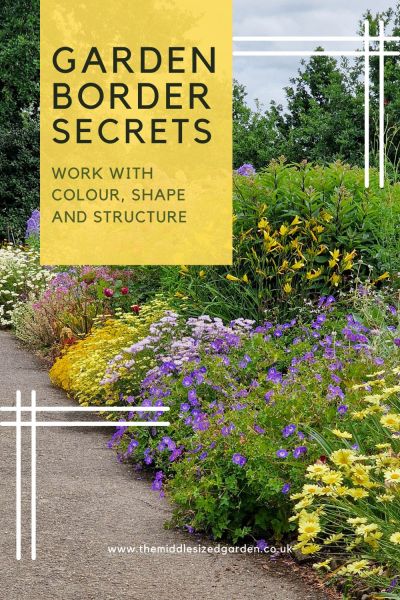
Yellow in borders – love it or loathe it?
Some gardeners – in the UK, at least – don’t want yellow flowers in their borders. But yellow can look stunning. I particularly love these yellow anthemis tinctoria in the Sunk Garden borders at Doddington Place, photographed in mid to high summer.
And at Borde Hill Gardens, anthemis tinctoria also provides a splash of yellow to contrast with blue campanula and geraniums in a long border designed by Chris Beardshaw. This photo is in mid summer, but I visited the gardens two months later and it was still in flower.
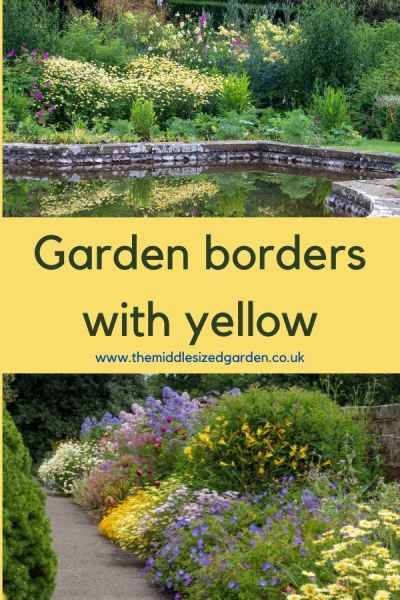
The top photo is one of the borders at Doddington Place Gardens, featuring Anthemis tinctoria (Golden marguerites). Anthemis also features in the borders in the picture below it, in a border designed by Chris Beardshaw at Borde Hill Gardens.
At Great Dixter, they love to tease any gardening preconceptions, so this border is yellow, yellow, yellow, either marigolds or chrysanthemums. I’m sorry that I can’t tell which at a distance. But marigolds and chrysanthemums are related, so perhaps it’s not surprising.
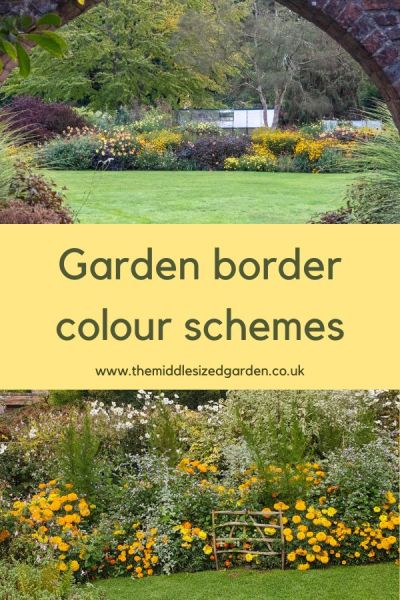
Yellow adds light to the rich, late season colours in the top photo at Great Comp Gardens in Sussex
And in late summer, yellow can lighten the burnt oranges and dark reds of a late season hot border. This long border at Great Comp Gardens in Kent looked magnificent throughout late summer and autumn.
A white garden border – cool and classical
Ever since Vita Sackville West designed the White Garden at Sissinghurst, there’s been a kind of magic about white borders. If you combine good evergreen structure, such as topiary and beautifully shaped trees and shrubs, with white flowers, you have a garden that looks good all year round. And you can find white flowers for any time of year, from snowdrops and tulips through to roses, dahlias and chrysanthemums.
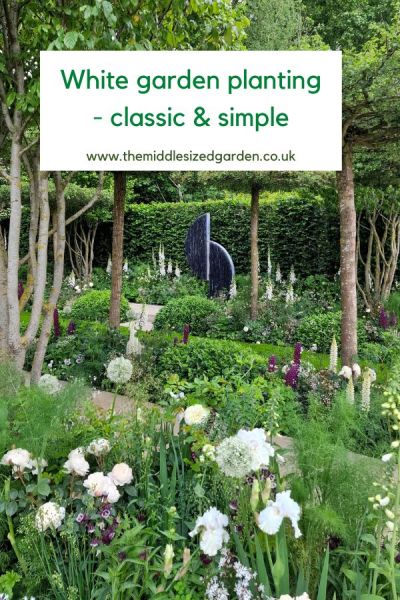
This show garden for the charity Perennial majors on white flowers with evergreen structure. It’s designed by Richard Miers and it won the People’s Choice Award at Chelsea last year. That’s because so many people loved its classical simplicity.
But I have two words of warning about white. Firstly, not all plants labelled as ‘white’ turn out to have white flowers. So you may have other colours popping up. That can be nice – Richard Miers has added splashes of red to this garden.
Secondly, I went to a talk by gardening guru Sarah Raven. She says that if you combine white with other colours, you need to be careful. Whites mix well with pastels, because the pastels have lots of white in them.
But if you add white flowers to a border full of richer, darker colours, the white has all the light. And the other colours can look dull and dark in contrast instead of rich and glowing.
I realised that was partly what was wrong with my border. The parts where reds, pinks and oranges mixed was more vibrant than the part where one white flower had been dropped in.
White plus other colours – smart and stylish
Several friends of mine have a garden border where white is partnered with another colour or two colours. At Karori, my brother-in-law and sister-in-law have a ‘red, white and silver’ border, which looks good for months on end. The ‘silver’ comes from grey foliage, which adds so much to any border.
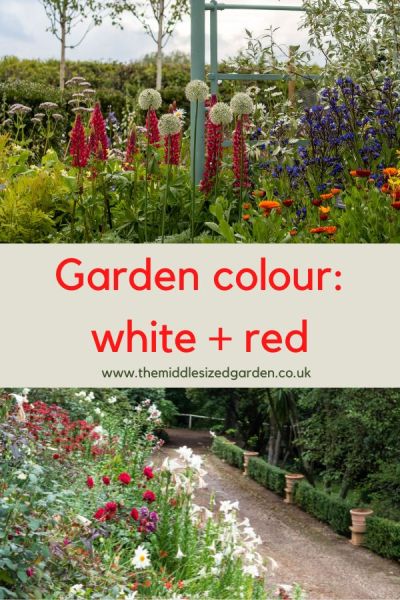
The top photo shows ‘Noble Series’ lupins and Allium ‘Mount Everest’ at Hardy’s Cottage Garden plants. The picture below it shows a red, white and silver border scheme in a private garden.
The contrasting red and white in a show border at Hardy’s Cottage Garden Plants in Dorset also works very well. The company has 24 Gold medals at RHS Chelsea Flower Show for their plant displays and this one shows the advantage of contrasting plant shapes as well as plant colours. It’s a Band of Noble Lupin with Allium ‘Everest’. Rosy Hardy has some good tips on choosing perennials here.
And I also love the blue, white and silver ‘Ghost border’ at Doddington Place Gardens. I’ve seen this look equally good with white tulips and daffodils as with blue delphiniums in summer. In my post about English Country Style, podcaster and gardener Joff Elphick says that ‘blue delphiniums are key to the English country garden look.’ Personally, I’m very tempted.
Soft blues, lavender and pink for a very pretty garden border
One of my favourite colour scheme combinations is the soft blue/pink/lavender one. I find that it’s very good for early to mid summer, then from late summer onwards the hotter colours take over.
We visited West Dean Gardens to talk to head gardener Tom Brown about how to create stunning garden borders.
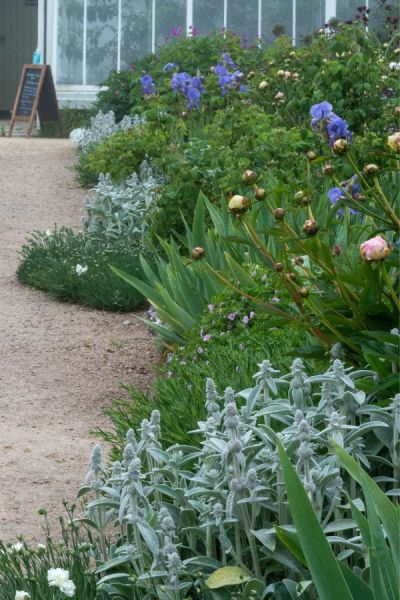
A section of the mid-summer borders at West Dean Gardens. The foliage shape and colour is as important as the flowers.
It was mid-summer and there were lovely soft blues and pinks in the two long borders. Tom’s advice was to plant in large clumps. He suggests 5,7 or 9 plants rather than the usual 3 that are recommended. The reason is that if you plant three and one dies, you’re not left with much of a clump. Looking at the borders, you can also see how important it is to contrast leaf shape and colour. Many people think irises are just for their flowers, but their sword-like leaves add real punctuation to this border.
And there are more soft pinks and reds in the 100ft long border at No Name Plants. Steve Edney and Lou Dowle have a strong sense of colour . Although the borders are full of life and movement, the colour range is quite disciplined. You can hear a fascinating discussion between them on whether a dark red persicaria belongs in the border in this video (it’s at around 14 minutes).
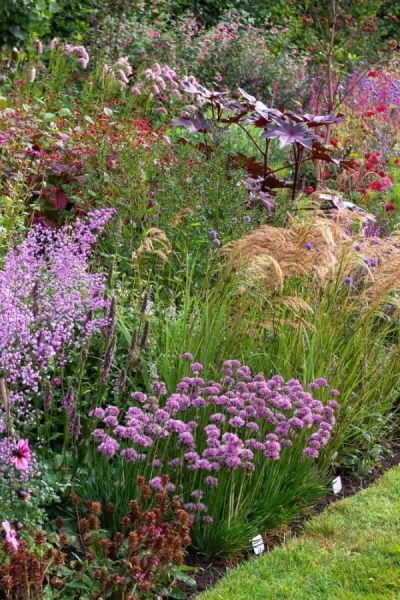
A superb use of reds and pinks, with a graded height planting, at the No Name Nursery in Kent.
Steve prefers the classical ‘graded heights’ system of planting in a herbaceous border. He suggests you move the heights up or down by a third. There’s more of his advice in how to create a stunning perennial border.
And I love this pretty English country border at Doddington Place Gardens, with its soft pinks and purples, too.
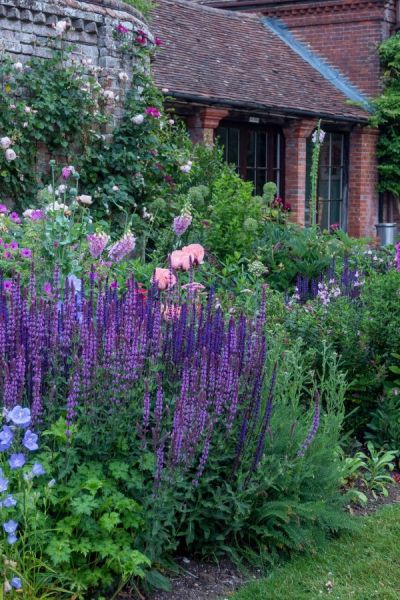
Soft pinks and purples at Doddington Place Gardens in Kent.
Hot borders – orange, red and gold
Some grand gardens have ‘hot’ and ‘cool’ borders. But I also think you can have a border that is cool with blues and pinks in summer, then turns ‘hot’ in autumn. One of the most stunning hot borders is the autumn border at Gravetye Manor Hotel.
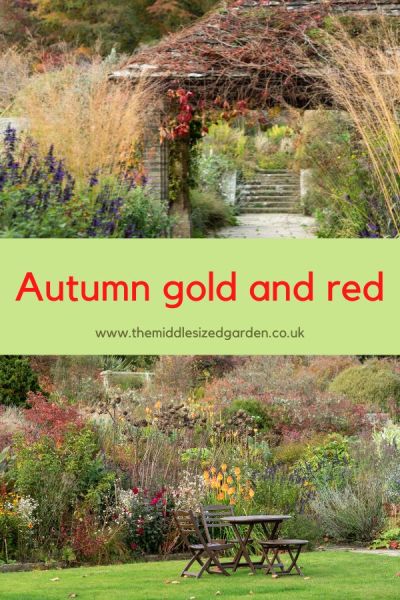
Autumn borders at Gravetye Manor Hotel. The grasses create movement and add a golden accent.
Or think about shape instead of colour
When I interviewed garden designer, Michael McCoy, he said that most gardeners get too obsessed with colour in their garden border. But they should be thinking about plant shape instead.
He advises combining vertical spires with rounded shapes and horizontal layers. He’s done this in this new perennial garden, with great success. He says that if the plant shape works, then colour can be almost irrelevant. Like Tom Brown, he plants in very large groups. That’s also key to the look. See more of Michael’s advice in Naturalistic planting design here.
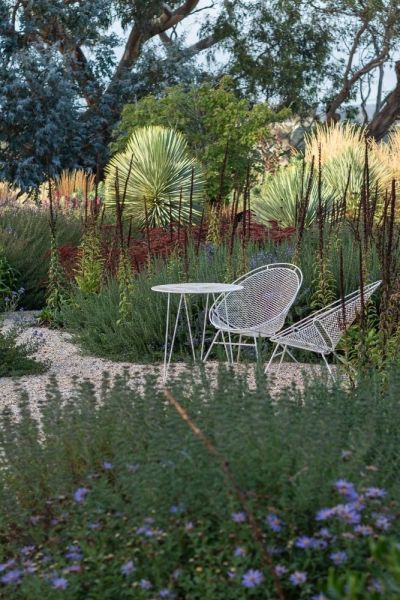
This dramatic planting by Michael McCoy is based on plant shape, not colour. There’s an effective contrast of rounded, vertical spires and horizontal planting.
Frances and Paul Moskovits also find they get better results by ignoring colour schemes. However, they have a different reason. In how to make a flower border look amazing, Frances says that she prioritises healthy plants that flourish in their area. A full border looks best and it also has fewer weeds, she explains. She found she had more failures when she got too obsessed with choosing flowers for their colour.
Don’t forget your costs!
Completely filling a border from scratch can be expensive. I’ve broken down eight ways to keep the costs down in how to Create A Garden Border on a Budget.
See more views of the gardens in video
You can see more of the borders I’ve mentioned in this video Brilliant Herbaceous Border Inspiration.
An easy way of listing plants for a garden border
When I was planning the re-vamp of our garden border, I realised there were lots of factors to consider. As well as colour, size and shape, there is also season, wildlife-friendliness and more. So I’ve created a Beautiful Borders Planning List. I can write down the plants I want, and can see where gaps are appearing by looking down the columns.
The Beautiful Borders Planning Checklist is free to download here.
Pin to remember garden border tips
And do join us for a free weekly email with more gardening tips, ideas and inspiration.
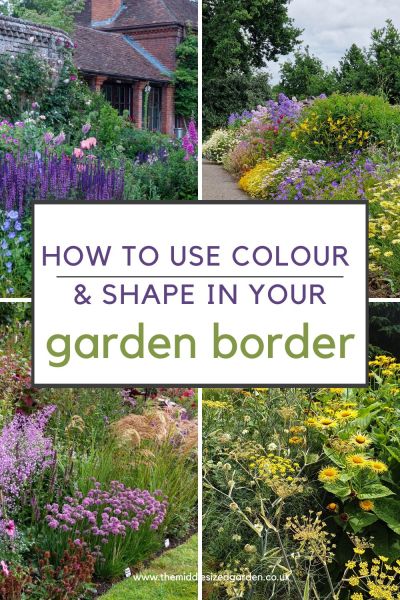

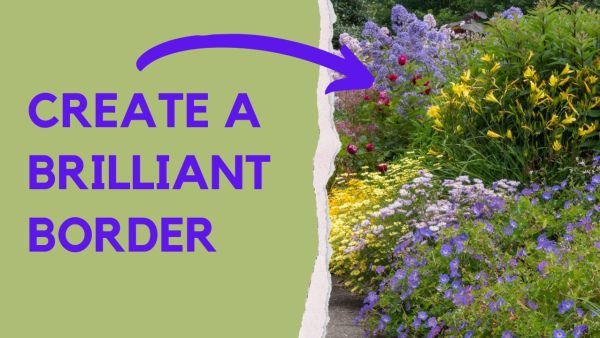























Incredibly helpful. Thank you. Thank you. Thank you
Thank you